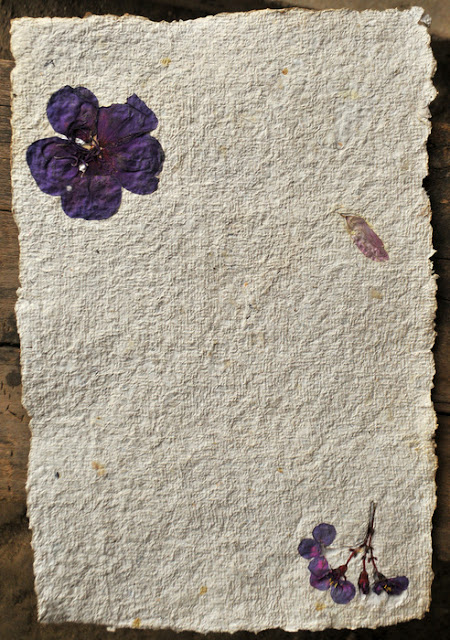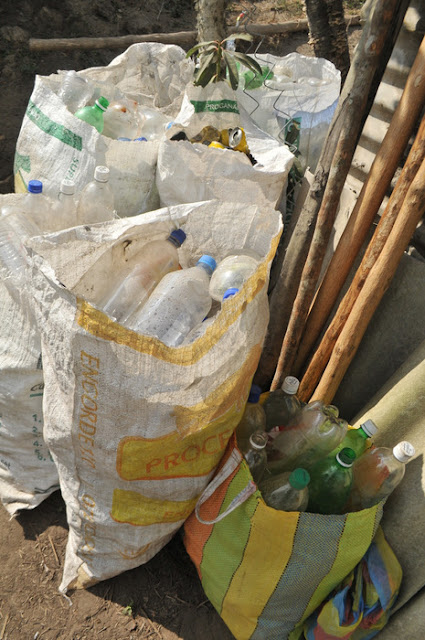I realized as I write this that I am, in fact, almost halfway through my stay in my new site. I guess it's not my 'new' site anymore, but my permanent site.
Five months has gone by fast, but I still went through the normal cultural adjustment stages. When I arrived, everything was fantastic and new and nothing could be bad. Then I sank into confusion about what to do. Then I missed 'home,' home in the general term for the States. Since then it's pretty much been up and down on a daily or hourly basis. I still have some days where I prefer to just stay home and read or make something. I'm grateful for the days when I have a mountain of laundry to wash by hand, or I have to spend some time forraging for plants for my rabbit. Sometimes I walk the hour down the mountain to Apuela for internet even though someone in town offers his computer and internet for an hourly fee. I just like to go.
I've focused completely on trash management, at first only on accident. I think it started when I made my recycled art projects on the benches outside one of the two stores in town. The store owner started making her own folded chip bag wallet, then others picked up on it. I did just a couple workshops at the afternoon kids' group and more adults began their own projects. Once I began teaching recycled art in the school, many parents and their families got interested and started their projects.
I've also been helping out in the tree nursery, but so far progress has been pretty disappointing. I can only convince the other workers to do something if there's a tourism group coming to visit. We tried moving the workday from Friday to Monday and tried to assign a daily schedule to water the trees (only 15 minutes!) but nothing worked. Now it's pretty much just me and another American volunteer who are watering the trees every day so they don't die.
The tree nursery is really interesting though. First, it's a joy to see seeds germinate and near-dead twigs come blooming back to life with the copious water we bring. And with that comes more wildlife. One tree, a chinchin as it's known, is host to the larva of a big yellow butterfly. Its larva are green and spiky and have a colorful purple, green or pink crysallis. I used to take some home to watch:
I haven't travelled much at all since moving sites. Technically there's a rule in Peace Corps that says if you move sites, you can't take vacation for three months. Which was fine because I didn't have any money to climb mountains. Pretty sad actually. But I for sure didn't pass up the fantastic whale migration whose hub is Puerto Lopez. It didn't disappoint this year and we even visited Isla de la Plata to glimpse blue-footed boobies (and red-footed boobies and Nazca boobies). It was a nice break...
When I returned home, my family celebrated my birthday! It was a wonderful surprise complete with cake brought in from 'outside'. As you can see, it didn't completely survive the three-hour car ride:


Last month I began working on a recycling project. There had been a program before my time but it didn't take. My plan was to imitate another Peace Corps Volunteer's successful project in Santo Domingo by holding a recycling contest in the school. My project ended up being a little different than hers as a couple months ago a group of volunteers literally filled my room with donations of toys, art supplies, and school supplies. I was at a loss for what to do with the stuff and really didn't want to be the one to hand it all out like charity. Using the stuff as prizes seeing to be the solution. So a few community members and I finished the small recycling center on the corner of the football field by completely enclosing it with metal screen and finishing it with a nice door and lock. This was partly because we didn't want anyone taking away the plastic bins, to keep dogs out, and to keep kids from taking materials out to reuse in the contest.

I was really exited when my host mom Alicia began collecting bottles right away:
Then her pile grew:
And grew:
Not many kids brought in recyclables the first week of the contest, but once it was clear to them that the program was on, they bombarded me with bags filled with bottles. This was the second week:
The third week, we had to organize the small recycling center. I invited the kids to earn 10 points per family if they helped me crush all the bottles. What a BAD bad idea. Ten kids in a small space stomping on a couple thousand bottles. I regreted my decision immediately, but a few actually worked and in a couple hours we had finished the work. The next day I tied up the bags and weighed them out - 80 kilos of plastic and 6 kilos of metal plus a bit of cardboard. That's roughly equivalent to $21. 80 kilos of plastic represent about 2,700 bottles of various sizes.

Like I said earlier, I haven't had time or money to climb any big mountains. I'm for sure aching for the exercise and the adventure though. When a couple tourists came through and requested a guided hike, the guide invited me along to get to know the mountain above us where our town's water comes from. I had a bad cold but I pushed through it anyway (mistake, as it then progressed to a nasty sinus infection). The top is covered in forest and is inhabited by Andean bears. We didn't see any of the shy creatures, but we saw plenty evidence of their existence.
There have been a number of festivals in the area, including one where all the communities in the area gather with colored torches corresponding to their community (mine was white) and walk down to the town of Apuela for a nighttime Catholic mass. It was quite stunning but of course that was the time my camera battery decided to no longer hold a charge.
Roughly every Saturday, a few women, their kids and I get together to work on recycled art projects. Most of them have worked on the folded chip bag wallets but they seem to prefer paper bead making.



One of the women is a brilliant crocheter whose crafts are sold in the Intag store in Otavalo. After I taught the schoolchildren to make plastic string for knitting, this artisan learned from her daughter and began making all kinds of amazing things. One of her products was a traditional hat crocheted from black and transparent plastic string. She likes the material so much that she now wants to buy new plastic bags...whoops...not really the point of reducing and recycling! What's really ironic, though, is she's a cabuya artist. She makes things out of a fiber produced from a big agave-like plant called the penca. The fiber is called cabuya. Before traffic arrived in Pucara and with it plastic products, these cabuya artisans wove bags to sell. When plastic bags arrived, they pretty much snuffed this trade out of existence and now the artisans make their crafts to sell as purses and such for tourists. Now these artisans know how to make string out of plastic and are crocheting that in plastic bags. Funny...like an inversion.



About it for now...to be continued!

























































